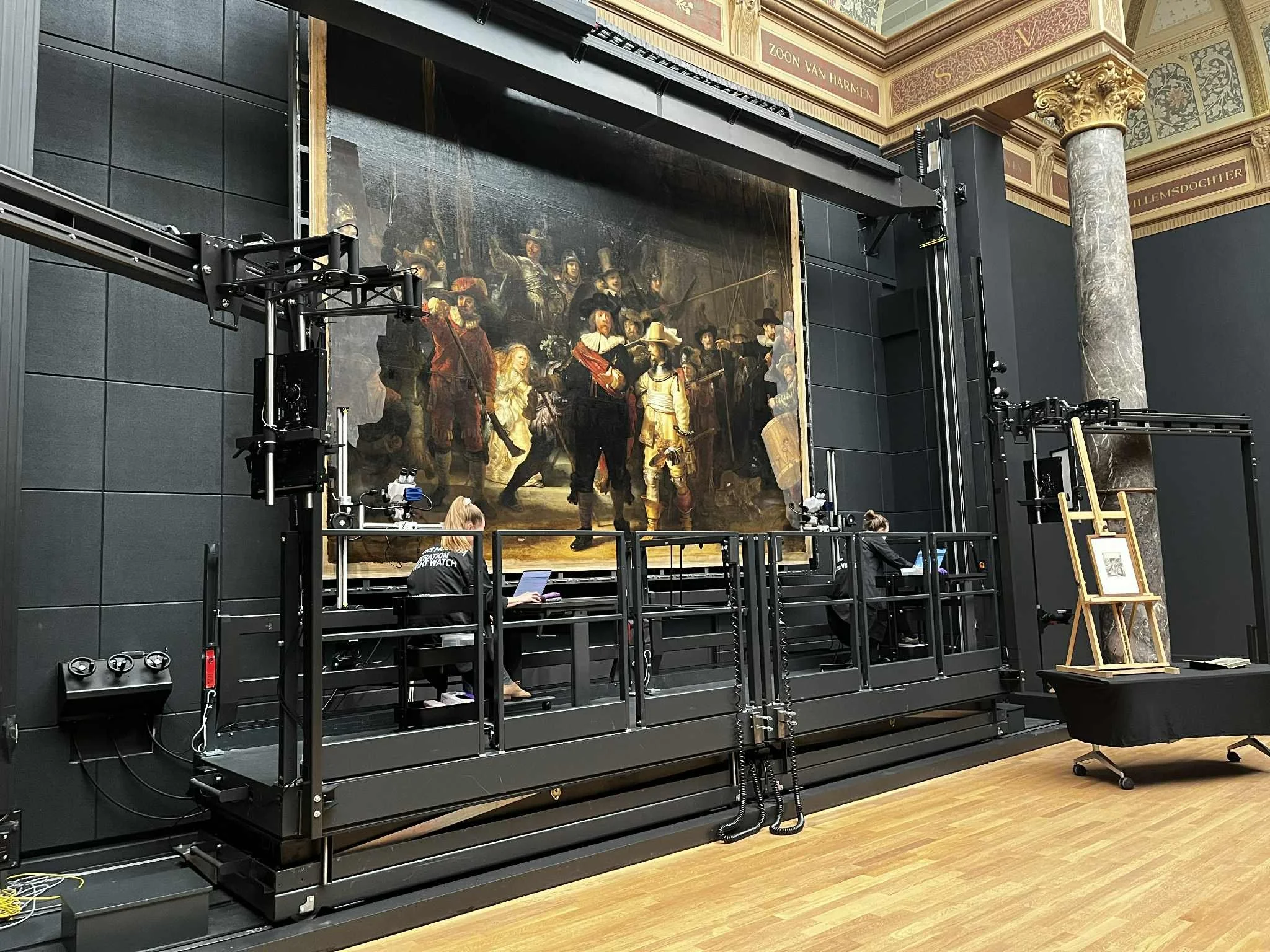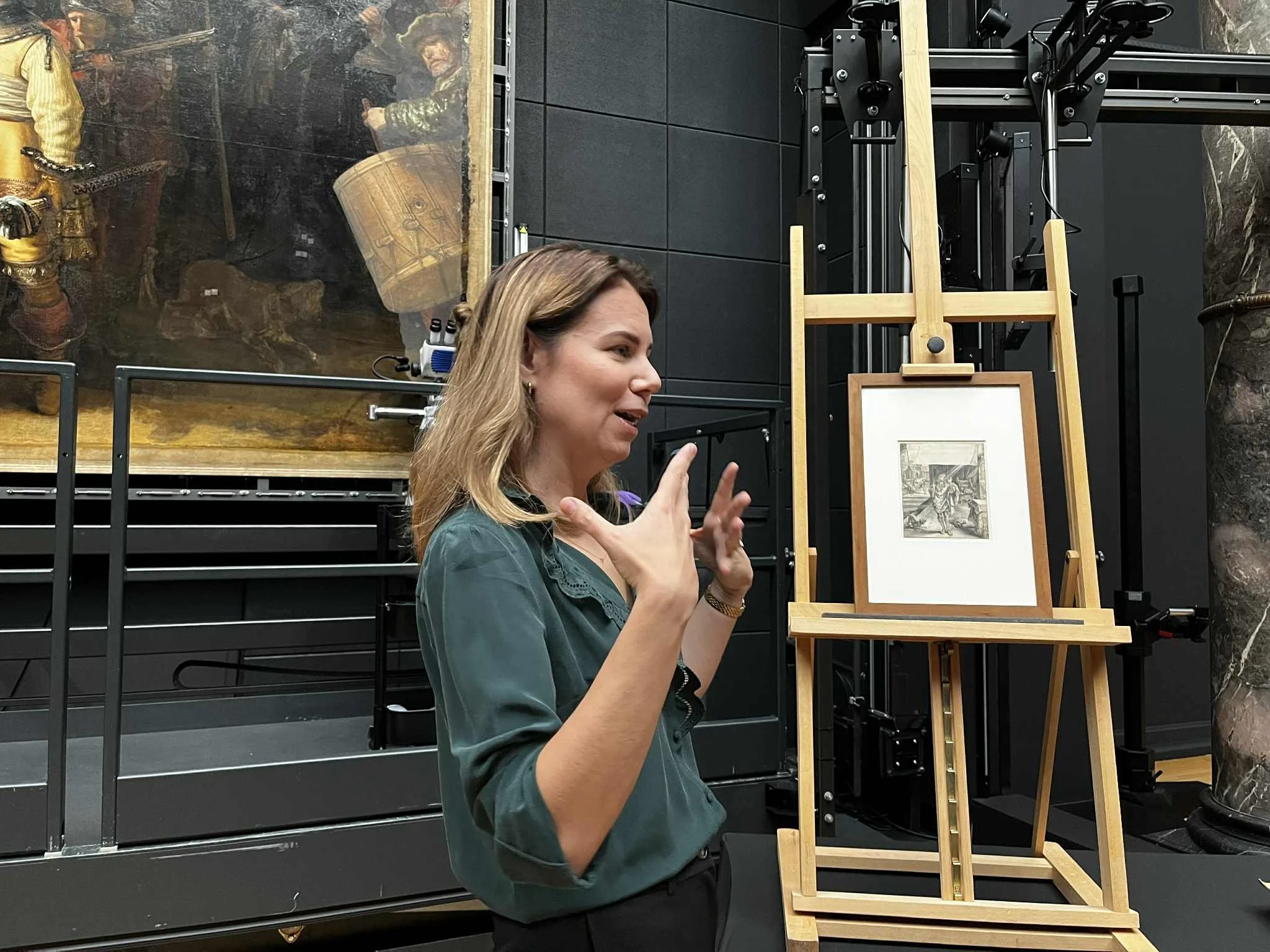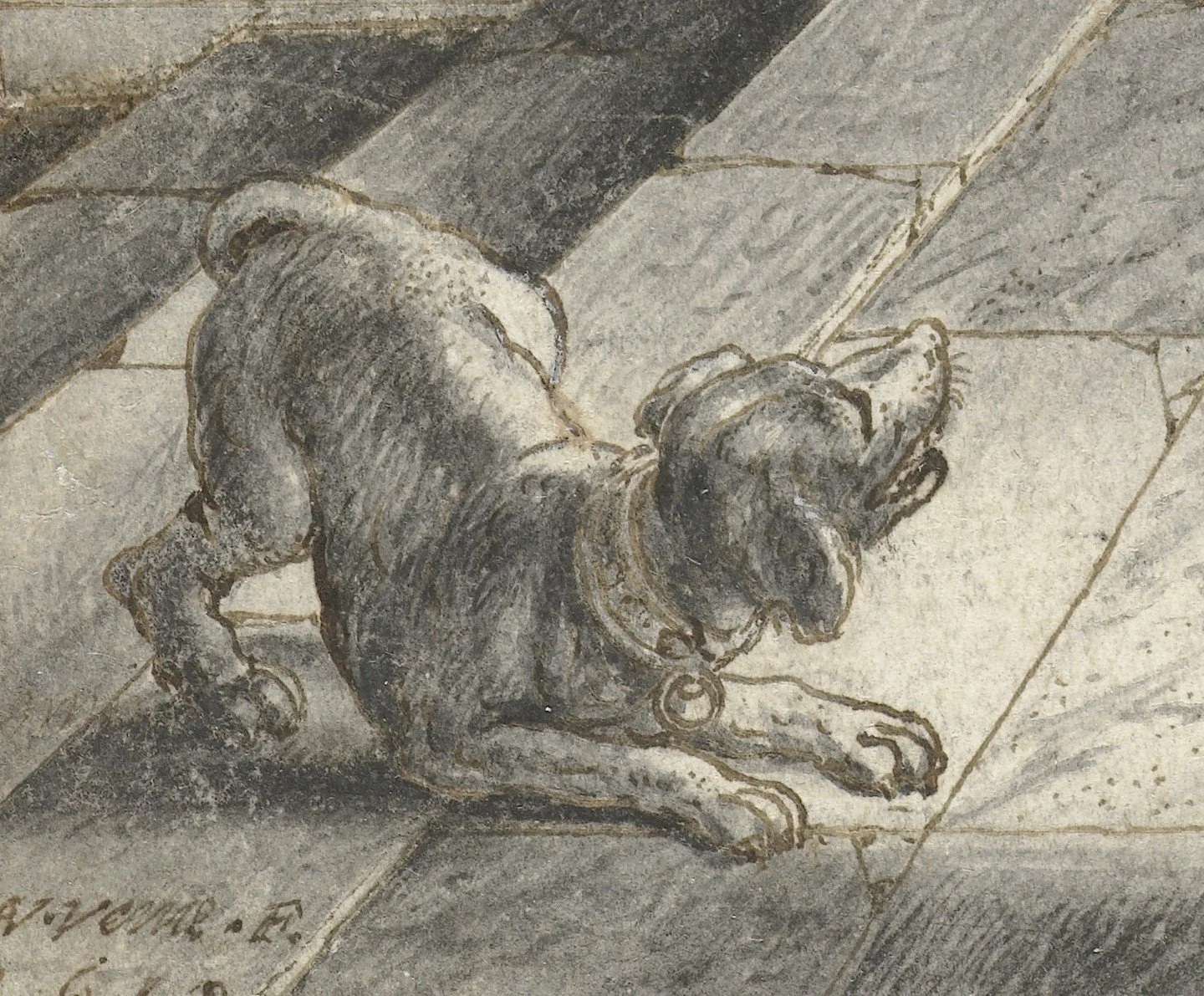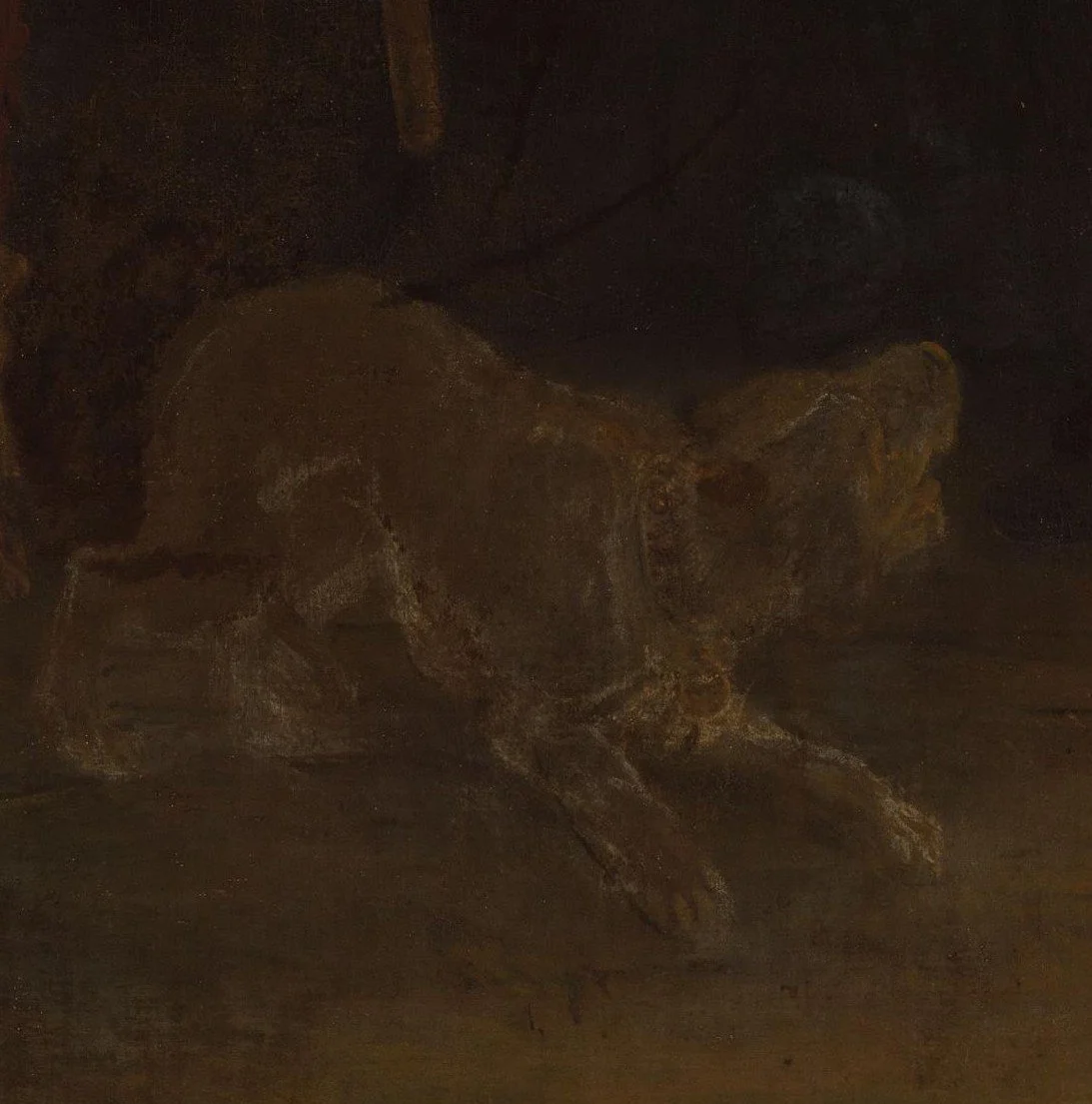Operation Night Watch: Rembrandt’s dog
You’d think there’s nothing left to discover in a painting by Rembrandt, such as The Night Watch. It is probably the most meticulously studied work of the great painter. In fact, The Night Watch is in a research and restoration process since 2019. That’s precisely why the latest discovery made by a curator at the National Museum in Amsterdam, the Rijksmuseum, managed to surprise.
The Nightwatch, Rembrandt, 1642. Photo: Claudia Marcu
The discovery has nothing to do with Captain Banning Cocq, his lieutenant, or any of the other figures in this scene painted by Rembrandt. Not even with the little girl with blonde pigtails, so generously bathed in light. In fact, it’s about... the dog. Yes, the dog that seems to be barking (or at least reacting) to the drummer on the right side of the composition. Over time, the pigments have deteriorated, and the animal has visibly faded. And yet, once you notice it, its silhouette clearly stands out.
Today, we found out that Rembrandt had a model for this four-legged character that he included in the scene. It’s a drawing by another Dutch artist, Adriaen van de Venne, active in the early 17th century. The resemblance between the two representations is so striking that it prompted curator Anne Lenders to delve deeper into the research.
Anne Lenders, curator Rijksmuseum. Photo: Claudia Marcu
During my studies of art history at the University of Amsterdam, I remember a course conducted by one of my favourite professors, Elmer Kolfin. It was called “Looking at Dutch Art 1600-1700.” At one moment we had to identify the sources of inspiration for different paintings signed by artists like Frans Hals or Jan Steen. How do you separate the master from a follower? I remember how Kolfin ended one of the lectures: no painter started from scratch. Each painter looked to those before him, at compositions and techniques. And when you respected your self as an artists you always wanted to be better that those before you.
So it is no surprise that even the great Rembrandt needed inspiration. It is well known that he was an avid collector of drawings and prints, which he studied carefully. Everything was important to him: facial expressions, hand movements, body positions, etc.
“What’s interesting for us is that The Night Watch is Rembrandt’s masterpiece. We always assume that Rembrandt, as a genius artist, created things out of nothing. And, in fact, we don’t take into account that he also borrowed from others,” said Taco Dibbits, director of the Rijksmuseum, during a press meeting today.
A simple visit to an exhibition led to this fascinating discovery. The dog in a drawing by the Dutch artist Adriaen van de Venne immediately reminded the curator Anne Lenders of the dog in The Night Watch.
Van de Venne Rembrandt
The rotation of the heads of the two dogs is the same, their gaze is directed upwards and in the same direction, and their mouths are slightly open. Even the collars they wear around their necks are very similar. Their posture is also similar.
However, there are differences: Rembrandt’s dog has its tongue out, a flatter nose, and is standing on all four legs, unlike Van de Venne’s dog, which rests on its front legs, with its chest touching the ground.
This is a very important discovery for the history of the painting, adds Taco Dibbits:
“It’s fascinating how Rembrandt chooses a corner that is, in fact, a bit in the shadows and in the dark, not very interesting, but he makes it captivating by adding a bit of action. All those civic guards standing there, and the dog is in a very agitated environment, very noisy. Van de Venne’s dog, on the other hand, is in a more relaxed, calm posture. It would’ve been very strange for Rembrandt to copy that dog exactly as it was. But he adapts it, and in doing so, the dog seems like it could run off at any moment. This enhances the liveliness of the painting. And, as a viewer, when you stand before it, you really feel that something is about to happen at any moment. The dog plays a very important role in that.”
But why a dog? I asked Anne Lenders what the significance of a dog was in the 17th-century Dutch painting and, more specifically, in The Night Watch.
A.L.: “In the group portraits of civic guards the dog was a constant presence, a symbol of loyalty and vigilance. But I believe Rembrandt used it here more for the dramatic effect.”
The drawing by Adriaen van de Venne (1590–1662) dates back to 1619. The composition illustrates a biblical scene in which Joseph is being seduced by Potiphar’s wife. The drawing served as a model for an engraving that appears on the title page of a widely circulated 17th-century volume by Jacob Cats: The Inner Struggle, that is, the Powerful Movement between Flesh and Spirit (1620). It is very likely that Rembrandt consulted either the drawing, the engraving, or possibly both.
Jacob Cats, 1620. Photo: Claudia Marcu
The Night Watch contains other elements inspired by the works of fellow artists as well. In 2009, issue no. 1 (volume 57) of the Rijksmuseum Bulletin, the official journal of the National Museum in Amsterdam, was almost entirely dedicated to The Night Watch. Historian Dudok van Heel offered a new interpretation of the painting’s meaning and managed to identify every individual in the group.
That’s when it was revealed, for example, that for the portrait of Captain Banninck Cocq, Rembrandt drew inspiration from the captain’s wedding portrait, painted in 1630. More precisely, Rembrandt gave the captain a collar similar to the one he wore in his wedding portrait, an accessory that was already out of fashion by the mid-17th century.
Frans Banninck Cocq, Wybrandt de Geest, 1630. Photo: Prinsenhof Museum Delft (left)
Frans Banninck Cocq, Rembrandt, 1642, fragment from The Nightwatch. Photo: Rijskmuseum (right)
The character dressed in red, from behind whom the little girl emerges, is also wearing costume elements that were outdated at the time, borrowed from various engravings, such as one created by Hendrik Goltzius in 1587.
Standard bearer, H.Goltzius, 1587. Photo: Rijksmuseum (left)
Rembrandt, 1642, fragment from The Nightwatch. Photo: Rijskmuseum (right)
For the character standing behind the lieutenant, Rembrandt drew inspiration from an illustrated book depicting various soldiers’ positions, De Wapenhandelinghe from 1607, with engravings by Jacques de Gheyn. The gaze directed at the weapon and the way the character holds it are nearly identical to one of the poses in that manual.
Soldier, Jacques de Gheyn, 1600. Photo: Rijksmuseum (left)
Rembrandt, 1642, fragment from The Nightwatch. Photo: Rijskmuseum (right)











